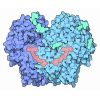[English] 日本語
 Yorodumi
Yorodumi- PDB-7w2s: Crystal structure of TxGH116 E730A mutant from Thermoanaerobacter... -
+ Open data
Open data
- Basic information
Basic information
| Entry | Database: PDB / ID: 7w2s | ||||||||||||||||||
|---|---|---|---|---|---|---|---|---|---|---|---|---|---|---|---|---|---|---|---|
| Title | Crystal structure of TxGH116 E730A mutant from Thermoanaerobacterium xylanolyticum with glucose | ||||||||||||||||||
 Components Components | Glucosylceramidase | ||||||||||||||||||
 Keywords Keywords | HYDROLASE / TxGH116 / beta-glucosidase / mutant / Thermoanaerobacterium xylanolyticum / glucose | ||||||||||||||||||
| Function / homology |  Function and homology information Function and homology informationglucosylceramidase / glucosylceramide catabolic process / glucosylceramidase activity / beta-glucosidase activity / carbohydrate metabolic process / metal ion binding / membrane Similarity search - Function | ||||||||||||||||||
| Biological species |  Thermoanaerobacterium xylanolyticum (bacteria) Thermoanaerobacterium xylanolyticum (bacteria) | ||||||||||||||||||
| Method |  X-RAY DIFFRACTION / X-RAY DIFFRACTION /  SYNCHROTRON / SYNCHROTRON /  MOLECULAR REPLACEMENT / MOLECULAR REPLACEMENT /  molecular replacement / Resolution: 1.85 Å molecular replacement / Resolution: 1.85 Å | ||||||||||||||||||
 Authors Authors | Huang, M. / Pengthaisong, S. / Charoenwattanasatien, R. / Jitonnom, J. / Ketudat Cairns, J.R. | ||||||||||||||||||
| Funding support |  Thailand, 5items Thailand, 5items
| ||||||||||||||||||
 Citation Citation |  Journal: Catalysts / Year: 2022 Journal: Catalysts / Year: 2022Title: Systematic Functional and Computational Analysis of Glucose-Binding Residues in Glycoside Hydrolase Family GH116. Authors: Huang, M. / Pengthaisong, S. / Charoenwattanasatien, R. / Thinkumrob, N. / Jitonnom, J. / Ketudat Cairns, J.R. | ||||||||||||||||||
| History |
|
- Structure visualization
Structure visualization
| Structure viewer | Molecule:  Molmil Molmil Jmol/JSmol Jmol/JSmol |
|---|
- Downloads & links
Downloads & links
- Download
Download
| PDBx/mmCIF format |  7w2s.cif.gz 7w2s.cif.gz | 183.7 KB | Display |  PDBx/mmCIF format PDBx/mmCIF format |
|---|---|---|---|---|
| PDB format |  pdb7w2s.ent.gz pdb7w2s.ent.gz | 140.3 KB | Display |  PDB format PDB format |
| PDBx/mmJSON format |  7w2s.json.gz 7w2s.json.gz | Tree view |  PDBx/mmJSON format PDBx/mmJSON format | |
| Others |  Other downloads Other downloads |
-Validation report
| Summary document |  7w2s_validation.pdf.gz 7w2s_validation.pdf.gz | 2.7 MB | Display |  wwPDB validaton report wwPDB validaton report |
|---|---|---|---|---|
| Full document |  7w2s_full_validation.pdf.gz 7w2s_full_validation.pdf.gz | 2.7 MB | Display | |
| Data in XML |  7w2s_validation.xml.gz 7w2s_validation.xml.gz | 32.1 KB | Display | |
| Data in CIF |  7w2s_validation.cif.gz 7w2s_validation.cif.gz | 48.2 KB | Display | |
| Arichive directory |  https://data.pdbj.org/pub/pdb/validation_reports/w2/7w2s https://data.pdbj.org/pub/pdb/validation_reports/w2/7w2s ftp://data.pdbj.org/pub/pdb/validation_reports/w2/7w2s ftp://data.pdbj.org/pub/pdb/validation_reports/w2/7w2s | HTTPS FTP |
-Related structure data
| Related structure data | 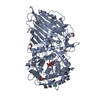 7w2tC 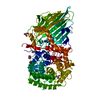 7w2vC 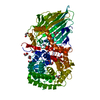 7w2wC 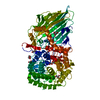 7w2xC 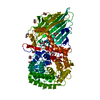 5bvuS S: Starting model for refinement C: citing same article ( |
|---|---|
| Similar structure data | Similarity search - Function & homology  F&H Search F&H Search |
- Links
Links
- Assembly
Assembly
| Deposited unit | 
| ||||||||
|---|---|---|---|---|---|---|---|---|---|
| 1 |
| ||||||||
| Unit cell |
|
- Components
Components
-Protein / Sugars , 2 types, 2 molecules A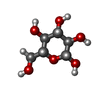

| #1: Protein | Mass: 96534.398 Da / Num. of mol.: 1 / Mutation: E730A Source method: isolated from a genetically manipulated source Source: (gene. exp.)  Thermoanaerobacterium xylanolyticum (strain ATCC 49914 / DSM 7097 / LX-11) (bacteria) Thermoanaerobacterium xylanolyticum (strain ATCC 49914 / DSM 7097 / LX-11) (bacteria)Strain: ATCC 49914 / DSM 7097 / LX-11 / Gene: Thexy_2211 / Plasmid: pET30a / Production host:  |
|---|---|
| #2: Sugar | ChemComp-BGC / |
-Non-polymers , 4 types, 449 molecules 






| #3: Chemical | ChemComp-GOL / #4: Chemical | #5: Chemical | ChemComp-CA / | #6: Water | ChemComp-HOH / | |
|---|
-Details
| Has ligand of interest | Y |
|---|
-Experimental details
-Experiment
| Experiment | Method:  X-RAY DIFFRACTION / Number of used crystals: 1 X-RAY DIFFRACTION / Number of used crystals: 1 |
|---|
- Sample preparation
Sample preparation
| Crystal | Density Matthews: 2.28 Å3/Da / Density % sol: 41.18 % |
|---|---|
| Crystal grow | Temperature: 288 K / Method: vapor diffusion, hanging drop Details: 0.2 M AMMONIUM SULFATE, 22% PEG 3350, 0.1 M MES, PH 5.5 |
-Data collection
| Diffraction | Mean temperature: 100 K / Serial crystal experiment: N |
|---|---|
| Diffraction source | Source:  SYNCHROTRON / Site: SYNCHROTRON / Site:  NSRRC NSRRC  / Beamline: BL13B1 / Wavelength: 1 Å / Beamline: BL13B1 / Wavelength: 1 Å |
| Detector | Type: ADSC QUANTUM 315r / Detector: CCD / Date: Nov 13, 2019 |
| Radiation | Protocol: SINGLE WAVELENGTH / Monochromatic (M) / Laue (L): M / Scattering type: x-ray |
| Radiation wavelength | Wavelength: 1 Å / Relative weight: 1 |
| Reflection | Resolution: 1.85→30 Å / Num. obs: 70181 / % possible obs: 99.8 % / Redundancy: 6.7 % / Rmerge(I) obs: 0.113 / Net I/σ(I): 16.5 |
| Reflection shell | Resolution: 1.85→1.92 Å / Rmerge(I) obs: 0.722 / Mean I/σ(I) obs: 1.9 / Num. unique obs: 6871 / CC1/2: 0.765 / % possible all: 99.5 |
-Phasing
| Phasing | Method:  molecular replacement molecular replacement |
|---|
- Processing
Processing
| Software |
| ||||||||||||||||||||||||||||||||||||||||||||||||||||||||||||
|---|---|---|---|---|---|---|---|---|---|---|---|---|---|---|---|---|---|---|---|---|---|---|---|---|---|---|---|---|---|---|---|---|---|---|---|---|---|---|---|---|---|---|---|---|---|---|---|---|---|---|---|---|---|---|---|---|---|---|---|---|---|
| Refinement | Method to determine structure:  MOLECULAR REPLACEMENT MOLECULAR REPLACEMENTStarting model: 5BVU Resolution: 1.85→30 Å / Cor.coef. Fo:Fc: 0.969 / Cor.coef. Fo:Fc free: 0.948 / SU B: 2.681 / SU ML: 0.079 / Cross valid method: THROUGHOUT / σ(F): 0 / ESU R: 0.122 / ESU R Free: 0.117 / Stereochemistry target values: MAXIMUM LIKELIHOOD Details: HYDROGENS HAVE BEEN ADDED IN THE RIDING POSITIONS U VALUES : REFINED INDIVIDUALLY
| ||||||||||||||||||||||||||||||||||||||||||||||||||||||||||||
| Solvent computation | Ion probe radii: 0.8 Å / Shrinkage radii: 0.8 Å / VDW probe radii: 1.2 Å / Solvent model: MASK | ||||||||||||||||||||||||||||||||||||||||||||||||||||||||||||
| Displacement parameters | Biso max: 72.51 Å2 / Biso mean: 22.621 Å2 / Biso min: 5.63 Å2
| ||||||||||||||||||||||||||||||||||||||||||||||||||||||||||||
| Refinement step | Cycle: final / Resolution: 1.85→30 Å
| ||||||||||||||||||||||||||||||||||||||||||||||||||||||||||||
| Refine LS restraints |
| ||||||||||||||||||||||||||||||||||||||||||||||||||||||||||||
| LS refinement shell | Resolution: 1.85→1.898 Å / Rfactor Rfree error: 0 / Total num. of bins used: 20
|
 Movie
Movie Controller
Controller


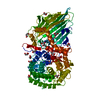
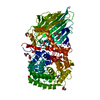
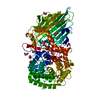
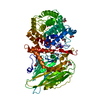
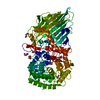
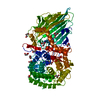
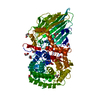
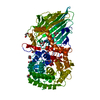
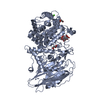
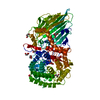
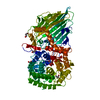
 PDBj
PDBj



